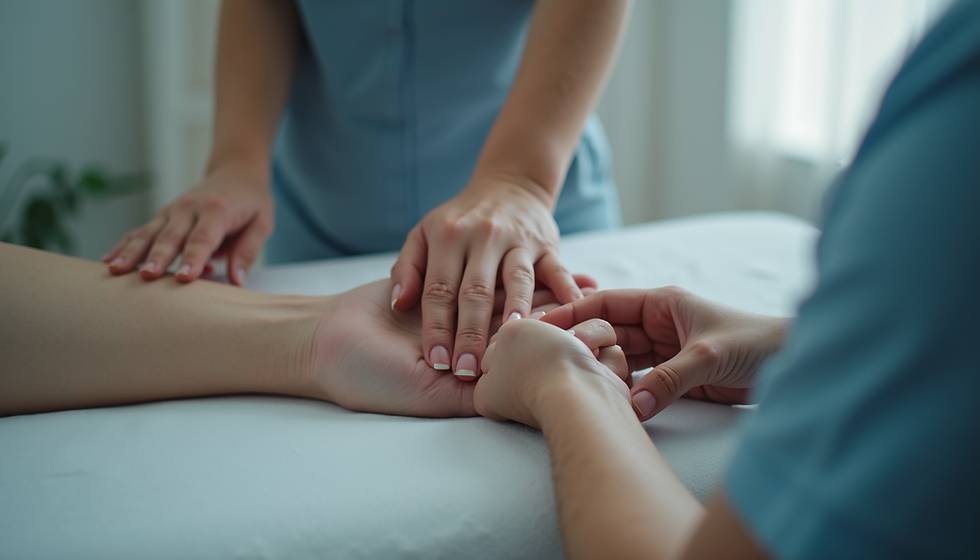Understanding the Benefits of Hands-On Physiotherapy
- drneedhi92
- Jun 4
- 4 min read
Physiotherapy plays a crucial role in rehabilitation and recovery from injuries. Among the various techniques used by physiotherapists, hands-on approaches like manual therapy are prominent. They focus on the physical manipulation of muscles and joints, which can significantly aid healing. In this post, we will explore the various benefits of hands-on physiotherapy.
What is Manual Therapy?
Manual therapy is a specialized field within physiotherapy focusing on hands-on techniques to treat musculoskeletal pain and dysfunction. This approach includes various methods—like soft tissue mobilization, joint mobilization, and manipulation— to improve mobility and reduce pain. Manual therapy primarily involves the assessment and treatment of musculoskeletal conditions using the physiotherapist's hands.
Many patients find great relief from conditions like back pain, neck pain, arthritis, and sports injuries through these techniques. Evidence shows that manual therapy can enhance healing, improve mobility, and even improve overall well-being.

Benefits of Hands-On Physiotherapy
Providing relief from pain is one of the most immediate benefits of manual therapy. Research shows that hands-on approaches can lead to significant reductions in pain levels, often within a few sessions. The techniques work by reducing muscle tension, promoting relaxation, and improving blood circulation to the affected area.
For example, studies suggest that patients with chronic lower back pain experience a notable decrease in discomfort after a series of manual therapy sessions. Moreover, patients often report that manual therapy complements other forms of treatment, helping them transition back to their daily activities more quickly.
Improved Range of Motion
Another key advantage of manual therapy is its ability to enhance a patient's range of motion. Many injuries and ailments lead to stiffness or restricted movement in joints and muscles. Manual therapy techniques effectively restore mobility by loosening tight muscles and mobilizing stiff joints.
For instance, a patient recovering from a shoulder injury may struggle with lifting their arm. Through targeted manual therapy, the physiotherapist can facilitate improved motion in the shoulder joint, making it easier for the patient to reclaim their regular activities like reaching or lifting.

Boosting Recovery and Rehabilitation
Hands-on physiotherapy is also pivotal in promoting quicker recovery and rehabilitation after injuries or surgeries. Manual therapy techniques can help improve lymphatic drainage, speeding up the removal of waste products from injured tissues. This accelerates the healing process and helps reduce swelling.
Statistics indicate that patients who engage in manual therapy during recovery often return to their pre-injury level of functionality more rapidly than those who rely solely on other treatments. As a result, physiotherapists often incorporate hands-on techniques into their rehabilitation programs for optimal results.
Enhanced Mental Well-being
The physical benefits of manual therapy often extend to mental health as well. Chronic pain can take a toll on a person's emotional well-being, leading to issues like anxiety and depression. Hands-on physiotherapy can help break this cycle by not only alleviating pain but also fostering a sense of comfort and care.
Patients frequently report feeling more relaxed and positive after sessions, which is essential for overall healing. Engaging with a physiotherapist through manual therapy creates a support system that contributes significantly to emotional health during recovery.
Individualized Approach
One of the most compelling aspects of hands-on physiotherapy is its personalized nature. Each treatment plan is tailored to the individual needs of the patient. A physiotherapist assesses the unique condition of every patient, considering factors like age, medical history, and physical capabilities before designing a hands-on treatment plan.
This individualized approach ensures that patients receive the specific care that their unique injuries require. In many cases, physiotherapists may also integrate other modalities with manual therapy techniques, ensuring comprehensive treatment.

Practical Recommendations for Patients
If you’re considering hands-on physiotherapy for your rehabilitation, several practical steps can enhance your experience:
Communicate Openly: Always discuss your symptoms and any concerns with your physiotherapist. This dialogue helps them tailor the treatment to your situation.
Stay Committed: Consistency is key in rehabilitation. Attend sessions as scheduled and practice any recommended exercises at home.
Follow Guidance: Your physiotherapist might suggest lifestyle adjustments to further facilitate recovery. Following these recommendations can lead to greater success.
Be Patient: Improvement takes time. Give your body the time it needs to heal effectively.
Incorporating these tips into your treatment can significantly enhance your experience and result in better outcomes. The combination of hands-on techniques and a proactive approach can lead to transformative changes in your physical health.
Exploring Future Prospects of Manual Therapy
As science and research progress, the scope of manual therapy continues to evolve. New techniques and methodologies are being developed, promising even greater benefits for patients. Emerging evidence-based practices will likely enhance its efficacy further, ensuring it remains a cornerstone in physiotherapy.
Physiotherapy clinics are increasingly utilizing advanced technologies alongside manual therapy, allowing for even more precise and guided treatments. The future looks promising, and integrating hands-on approaches with technological advancements will likely enhance therapeutic outcomes for patients.
In conclusion, understanding the benefits of hands-on physiotherapy, particularly through manual therapy techniques, is crucial for those seeking recovery and relief from pain. Personalized treatment plans, improved mobility, faster recovery, and better mental well-being make hands-on physiotherapy a valuable option for many individuals.
Through this exploration, we hope you gain insights into how manual therapy can benefit you or someone you know. Whether dealing with chronic pain or recovering from an injury, hands-on physiotherapy can pave the way for improved health outcomes and overall wellness.






Comments